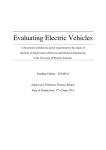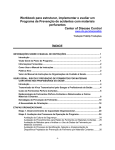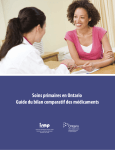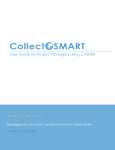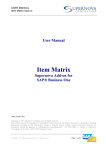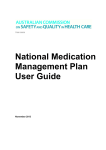Download User Guide - Australian Commission on Safety and Quality in Health
Transcript
National Quality Use of Medicines Indicators for Australian Hospitals: User Guide 2014 © Commonwealth of Australia 2014 and NSW Therapeutic Advisory Group Inc. This work is copyright. It may be reproduced in whole or in part for Australian quality improvement, study or training purposes subject to: • the inclusion of an acknowledgement of the source •indicators being reproduced without variation from the original. Requests and inquiries concerning reproduction and rights for purposes other than those indicated above requires the written permission of either: •Australian Commission on Safety and Quality in Health Care, GPO Box 5480 Sydney NSW 2001 or [email protected] •NSW Therapeutic Advisory Group Inc. PO Box 766, Darlinghurst NSW 2010 or [email protected] Suggested citation Australian Commission on Safety and Quality in Health Care and NSW Therapeutic Advisory Group Inc. (2014), National Quality Use of Medicines Indicators for Australian Hospitals. ACSQHC, Sydney. This document, with associated support materials, is available on the Australian Commission on Safety and Quality in Health Care web site at www.safetyandquality.gov.au and the NSW Therapeutic Advisory Group web site at www.nswtag.org.au ISBN 978-1-921983-78-8 (Online) ISBN 978-1-921983-79-5 (Print) Using the National Quality Use of Medicines Indicators for Australian Hospitals Why use the National QUM Indicators? The purpose of measuring indicators using clinical audit, analysis and interpretation of data is to inform and guide an ongoing program of local quality improvement activities.15-17 Results from local quality improvement activities can assist:18 • monitoring process performance • assessing if interventions to change structures and processes lead to improvements, providing feedback to clinicians and helping support practice improvements • assessing if improvements are maintained over time. The value of using indicators is fully realised with repeated measurement and coordinated action. It is recommended that: • indicator measurement is part of an ongoing, multidisciplinary local quality improvement activity • indicator measurement is embedded in routine clinical care • feedback is simple to understand and used by clinicians to guide everyday practice • interventions are undertaken in a supportive environment that includes appropriate structures, policies, systems, leadership and organisational culture. The National QUM Indicators are designed specifically for data collection as part of local quality improvement activities and can be used in a number of ways: • complementing information gained from the use of Medication Safety Self Assessment for Australian Hospitals (MSSA) tools.10,11 The MSSA tools assess medication safety structures and systems and systematically identify ways to improve them. Periodic measurement of indicators, such as annually, can help maintain safe medication systems. Using both the National QUM Indicators and MSSA tools assists hospitals to meet National Safety and Quality Health Service Standards2 and ensure that they have systems and processes in place for improving medication safety and quality use of medicines. • contributing to quality improvement activities using small-scale iterative methods such as the Plan-Do‑Study-Act (PDSA) cycle18,19 and using quality improvement models such as Clinical Practice Improvement and Continuous Quality Improvement.20-23 A useful quality improvement activity is drug use evaluation which is a multidisciplinary methodology for ensuring coordinated action to improve medicines use, and which can be used as part of ongoing and coordinated quality improvement programs.24 Use of indicators as part of a drug use evaluation process is a proven way to improve quality use of medicines in hospitals.25 Who should use the National QUM Indicators? The National QUM Indicators are designed primarily for use by clinicians involved in hospital medication management, especially doctors, nurses, and pharmacists. Ideally, clinicians directly responsible for patient care will be involved in the measurement of these indicators, interpretation of results and decisions about subsequent action. The indicators may provide evidence for accreditation purposes. Note: The National QUM Indicators are not designed for making comparisons between institutions (benchmarking) or for accountability purposes.15 When collecting data for these purposes, the sampling method needs to be tailored to the audit activity to ensure data collection is appropriate. Seek advice from the organisers of the activity before collecting data to ensure that definitions, sampling methods and guidelines for audit and reporting are agreed in advance and in consultation with the coordinating agency. Further information on inter-hospital comparisons is provided later in this section. National Quality Use of Medicines Indicators for Australian Hospitals 2014 1 National Quality Use of Medicines Indicators for Australian Hospitals Getting started Before starting any data collection activity, convene a multidisciplinary group of clinicians and other stakeholders to advise on the process. An advisory group could include: • clinicians of varying disciplines (e.g. medical, nursing, pharmacy) who have relevant expertise and understand the clinical process in question • sub-specialist clinicians relevant to the scope of specific indicators • people with relevant expertise in data collection, data analysis and clinical practice improvement methodology. The advisory group can advise on a number of factors including: • key stakeholders to consult prior to data collection, particularly clinicians and stakeholders whose practice may be affected • which indicators to use • what type of data collection is appropriate • how frequently to measure the indicator • which population to audit • whether sampling is required or data will be collected from the whole population • how many cases/records to include in the sample • how to ensure the sample is representative of the population • how to determine appropriate local performance targets • appropriate actions to take based on indicator results. 2 National Quality Use of Medicines Indicators for Australian Hospitals 2014 Optimising use of the National QUM Indicators: Key decisions The following pages provide advice for advisory groups and others involved in indicator collection and addresses the following key decisions: • Key decision 1: Selecting the overall approach to data collection –– intermittent data collection –– continuous data collection • Key decision 2: Selecting the approach to sampling –– collect data from the whole population or take a sample –– sample type • random • judgement –– sample size • calculated sample size • judgement sample size • Key decision 3: How to analyse data –– statistical analysis –– descriptive analysis • Key decision 4: How to present indicator results Key Decision 1: Selecting the overall approach to data collection There are two types of data collection processes that are commonly undertaken for quality improvement and evaluation of interventions: 1. I ntermittent data collection: data is collected relatively infrequently as a cross-sectional snapshot or a time series e.g. every six to twelve months. This approach may also be used for global project or program evaluation purposes18,26 to determine the overall impact of an intervention. 2. C ontinuous data collection: data is collected relatively frequently as a time series e.g. weekly, monthly or quarterly. This approach may be used as part of rapid cycle ongoing quality improvement activities, using methodology such as the Plan-DoStudy-Act cycles to assess performance of a given process and for data feedback purposes.26 Both intermittent and continuous indicator data collection processes are appropriate scientific approaches when used in the right circumstances. They may both be used in a quality improvement program.26 The approach taken to data collection is dependent on the purpose and context for measurement and can be guided by the advisory group. The choice of approach depends on a number of factors and should be based on local needs. Factors to consider include:18,27-31 • Purpose of indicator collection, such as: –– monitoring processes of care, implementation and evaluation of interventions • How the results will be used, such as: –– is inference from the sample to the whole population required? –– is assurance about how representative the results are required? –– is feedback to clinicians and key decisionmakers to influence practice required? –– is demonstration of statistical significance required? • Practicalities, such as: –– how difficult it is to find cases that are eligible for inclusion in the audit? –– how difficult it is to find the exact information in the medical record or elsewhere required for the audit? • Time and resources available to conduct: –– data collection –– analysis –– feedback –– reporting. Regardless of the approach chosen, indicator measurement needs to be ongoing. Indicators become meaningful when measurement is repeated regularly and trends can be monitored and acted upon in a timely way. Repeated indicator measurement allows an assessment of process stability which is important for understanding influences such as the impact of seasonal or chance variation on interventions. The advisory group can advise on how frequently to collect indicator data that is appropriate for the approach chosen, for example intermittent data collection or continuous data collection. Repeated indicator collection is easier when it is embedded into routine processes of care. Note: Data collection for many National QUM Indicators relies on good documentation in the medical record. In some cases, the desired process or procedure will occur without corresponding documentation. However, clear and complete medical record documentation, including discharge summary documentation, is a critical component of patient care.32 Lack of information and documentation are the second most commonly reported contributing factors to sentinel events in Australian hospitals.33 Additionally, breakdowns in medication management communication can result in adverse medicine events.34 The National QUM Indicators are therefore calculated using the assumption that if it is not documented, it is not done. In this way, they are intended to promote effective documentation and communication of medication management. National Quality Use of Medicines Indicators for Australian Hospitals 2014 3 National Quality Use of Medicines Indicators for Australian Hospitals Key Decision 2: Selecting the approach to sampling Is a sample needed? For many indicators, testing a sample from a population is recommended (rather than testing the whole population) because it is a more efficient use of time and resources. However, for some indicators it is possible to collect data from all cases in the population being studied rather than taking a sample.18,35 The advisory group can advise on the most appropriate approach as well as other key decisions required regardless of whether a sample is collected or not. See the example in Box 1. Box 1: Decisions on the approach to sampling Example: QUM Indicator 2.2: Percentage of prescriptions for restricted antibiotics that are concordant with drug and therapeutics committee approved criteria Hospital A The advisory group wanted to compile baseline information prior to the introduction of a local antimicrobial stewardship program. As part of this program they decided to use QUM Indicator 2.2: Percentage of prescriptions for restricted antibiotics that are concordant with drug and therapeutics committee approved criteria. This would provide baseline data but could also be used throughout the program to monitor program progress. Because they kept good records that were easily accessible, and knew how many people received restricted antibiotics each week, the advisory group decided to collect data on all patients prescribed restricted antibiotics over a one week period. In this case, sample type and size considerations were not required. Nevertheless the group needed to discuss whether they would take an intermittent or continuous approach to data collection. Discussions regarding audit frequency, whether frequent feedback to clinicians was required, how analysis would be undertaken and how the future activity would be guided by the results were undertaken prior to data collection. 4 National Quality Use of Medicines Indicators for Australian Hospitals 2014 Sample type Whether you are collecting a sample for intermittent or continuous data collection, a key decision is whether to collect a random (probability) or judgement (non-probability) sample. Both types of sampling are appropriate in different circumstances and each has strengths and limitations to consider. Definitions and factors to consider are outlined in Table 2. Table 2: Sample type considerations Random sampling 18,31,35,36 What is it? Why use it? Considerations A process of taking a sample so that each member of the population has an equal chance of selection. This removes bias and allows inferences to be made from the sample to the whole population. Random sampling should be considered if: It may be hard to define a fixed population from which to take a random sample given the dynamic nature of health care. • you need to infer from the sample to the whole population • you need assurance the results are representative of the population A small but important patient group could be missed if sampling is left to chance as part of random sampling especially if small samples are chosen. • it is a requirement of key stakeholders. There are different types of random sampling*. Consider seeking statistical advice regarding specific sampling needs. See examples in Box 2. Judgement sampling (also called purposive sampling) 18,19,28,31,36 A non-random process of taking a sample that draws on subject matter expertise to choose the most appropriate types and numbers of cases to include. Used when it’s important to exercise judgement in selecting the sample, rather than leaving this to chance. Consider judgement sampling when taking a random sample is not feasible or when you want to target a particular area, time of day or patient population. There is a risk of bias when using judgement sampling and this needs to be considered when interpreting data and may limit the conclusions that can be drawn. This is often a desired approach as it helps target activity to those areas it is important to understand. Although losing the ability to assess precision of results using traditional statistics, judgement sampling improves the ability to generalise on the basis of samples selected under a wide range of conditions and over time as improvements are made. See examples in Box 2. This approach is particularly useful for activities such as the PDSA cycle. *For more information about types of random sampling visit: www.abs.gov.au/ausstats/[email protected]/Latestproducts/A493A524D0C5D1A0CA2571FE007D69E2?opendocument A simple to use, random number generator is available at www.random.org/integers/ National Quality Use of Medicines Indicators for Australian Hospitals 2014 5 National Quality Use of Medicines Indicators for Australian Hospitals Box 2: Sample type decisions Examples: QUM Indicator 5.2: Percentage of patients with systolic heart failure that are prescribed appropriate medicines at discharge Hospital B: Intermittent indicator data collection with random sampling Hospital D: Intermittent indicator data collection with judgement sampling The cardiology department wanted to audit the use of ACE inhibitors and beta-blockers in systolic heart failure. An advisory group was convened to consider which sampling methodologies would best assure that the results are representative of all patients with systolic heart failure. As heart failure admissions vary during the year, X patients were randomly selected from all those admitted with systolic heart failure over the whole year. A simple random sampling method was chosen and repeated each year. The advisory group decided to do a snap shot audit including all patients with systolic heart failure over a defined period. They decided that one month’s worth of data would provide enough information for their needs. However they stipulated that data from a winter month must be used because they were aware their greatest numbers of admissions for heart failure were during these months. The auditor assessed their workload during these months and decided that collection during August was most feasible. Hospital C: Continuous indicator data collection with judgement sampling Stakeholders agreed that random sampling was not feasible and a judgement approach was preferred in this situation. The first Y patients admitted with systolic heart failure each month over the year were reviewed. Sample size For both intermittent and continuous indicator data collection, it is important to determine whether a sample size calculation is required or not. Key considerations are described in Table 3. Table 3: Sample size considerations What is it? Calculated sample size18,28,36,37 Why use it? Considerations Intermittent indicator data collection A sample size is the number of individuals required to include in the data collection activity so that there is assurance that the results are sufficiently precise. Consider calculating a sample size if: • you need to infer from the sample to the whole population • you need assurance the results are representative of the population An easy to use sample size calculator is available at www.openepi.com/ SampleSize/SSPropor.htm Discuss with stakeholders how precise the results are required to be, as this can affect the calculation of results. Consider seeking statistical advice. See examples in Box 3. • it is a requirement of key stakeholders. Continuous indicator data collection Not applicable: sample sizes are typically not calculated for continuous indicator data collection. See examples in Box 3. 6 National Quality Use of Medicines Indicators for Australian Hospitals 2014 Table 3: Sample size considerations (continued) What is it? Judgement sample size 7,12,18,19, 28,31,36 Why use it? Considerations Intermittent indicator data collection Advice from subject matter experts guides the sample size required by balancing degree of assurance required against resource constraints. Exact sample size recommendations cannot be given because they depend on variables such as the specific indicator used, the size of the hospital and what the expected performance is. The final determination will rely on the judgement of the advisory group overseeing the quality improvement activity. Consider taking a judgement sample size if: See Table 2. • there are resource/ practical difficulties in calculating a sample size • there is no need to infer from the sample to the whole • stakeholders feel this approach is satisfactory. Also see Table 2. Continuous indicator data collection As above A judgement sample size can be particularly useful for activities such as the PDSA cycle. Larger sample sizes generally lead to greater precision and ability to detect change. However, there is a point beyond which increasing sample size gives little improvement in the precision of results. Smaller samples can be collected if the test is repeated frequently. If a given sample is difficult to collect in one go, it can be collected at different times then collated. For example a sample of 15 can be collected as three samples of five. See examples in Box 3. National Quality Use of Medicines Indicators for Australian Hospitals 2014 7 National Quality Use of Medicines Indicators for Australian Hospitals Box 3: Sample size decisions Examples: QUM Indicator 5.8: Percentage of discharge summaries that contain a current, accurate and comprehensive list of medicines Hospital E: Intermittent indicator data collection with calculated sample size Hospital G: Continuous audit with judgement sampling size The hospital management requested information about discharge medication processes. During consultation with the key stakeholders, it was clear that assurance was required so that the results would be representative of the whole population. A small pilot study suggested that compliance was 60%. So a sample size calculation was done using a sample size calculator and a confidence interval of 0.05 (giving a precision of 5%). The results of this calculation showed that when 234 people were discharged on average each month, review of 144 records would be required to be 95% certain that results could be considered representative of the whole population. Review of 95 records would be required to be 80% certain. The advisory group decides that they are happy to proceed with 80% certainty and audit 95 discharge summaries. Repeat data collection is planned in 12 months. Hospital G is a relatively small hospital and the advisory group wanted to undertake intermittent data collection with a calculated sample size but felt they did not have the resources required to undertake this. Instead the group felt taking a smaller sample more frequently was more feasible. So the method was changed to continuous indicator data collection and a decision was made to collect data from 10 records a month over the next year, as this would provide adequate information. Over time the group noticed that missing records occurred frequently, so they agreed when that happened they would seek some additional records so they had data from 10 records each month. Hospital F: Intermittent indicator data collection with calculated sample size Hospital F averages 500 discharges per month and plans to implement a medication management plan (MMP) to assist medication reconciliation processes at discharge within the next 12 months. They plan to evaluate the impact of the MMP by measuring Indicator 5.8 before and after implementation. However the hospital does not know what its performance level with the indicator will be. The advisory group considers a recent publication showing a 60% compliance rate with a similar indicator. The hospitals in the study were quite different in size, but the advisory group decided to use the published result in their sample size calculation. Calculations showed review of 121 records would be required to be 80% certain that results can be considered to be representative of the whole population. 8 National Quality Use of Medicines Indicators for Australian Hospitals 2014 Hospital H: Continuous audit with judgement sampling size Hospital H had been considering an intermittent data collection with a calculated sample size, but as they were a large hospital the number of records required was too large for the resources available. They considered how others had done a similar data collection and referred to the Society for Hospital Medicine MARQUIS implementation manual http://tools.hospitalmedicine. org/resource_rooms/imp_guides/MARQUIS/ Marquis_Manual2011.pdf and followed their suggested strategy that recommends using 20 randomly selected patients per month. The key stakeholders were happy with this approach. Key Decision 3: How to analyse data For both intermittent indicator data collection and continuous indicator data collection, a key decision is whether to undertake statistical or descriptive analysis of the collected data. Statistical analysis of data allows for calculation of statistical significance and a high level of assurance that the results are “true”. Descriptive analysis of data provides a convenient and quick view of performance, and an indication of how performance is trending. However, with descriptive data it can sometimes be difficult to determine if observed changes are truly due to performance change or are due to chance. Key considerations are described in Table 4 below. Table 4: Considerations for analysing data What is it? Statistical analysis 16, 36, 38-41 Why use it? Considerations Intermittent indicator data collection When data have been collected randomly according to a calculated sample size and a valid biostatistical calculation performed, the results can be generalised from the sample to the whole population. Consider statistical analysis if: Statistical advice may be required to determine the correct statistical tests. • you need to infer from the sample to the whole population This is a useful method to consider for overall program evaluation.26 See examples in Box 4. • you need assurance the results are representative of the population • it is a requirement of key stakeholders. Continuous indicator data collection Statistical process control (SPC) is used to determine if a process is stable or if an intervention has led to improvement or meaningful change. Data are displayed graphically using run or control charts and this is assessed using defined rules. A control chart template has a centre-line (the mean), as well as upper and lower control limits. Figure 4 is an example of a control chart. Considerations as per intermittent indicator data collection. Benefits include: • identification of type of variation present – common cause or special cause variation • determination if improvements are statistically significant. Effective use of SPC requires training and a commitment to ongoing and repeated data collection and feedback. To be most helpful in assessing processes of care, SPC requires collection of at least 10 data points before the results can be analysed. Subject matter expertise is required to determine if improvements are clinically significant. A resource that may be helpful is the Institute of Healthcare Improvement Improvement Tracker: http://app.ihi. org/Workspace/tracker/ See examples in Box 4. Table 4 continued overleaf National Quality Use of Medicines Indicators for Australian Hospitals 2014 9 National Quality Use of Medicines Indicators for Australian Hospitals Table 4: Considerations for analysing data (continued) What is it? Descriptive analysis Why use it? Considerations Intermittent and continuous indicator data collection Data plotted as a bar chart or as a line graph provides a descriptive display of results. These methods are widely used and can help teams in their quality improvement activities. Figure 2 is an example of a bar chart used to provide feedback to clinicians. Consider descriptive analysis if there: • are resource and practical difficulties in statistical analysis • is no need to infer from the sample to the whole population • is a reduced need for assurance that results are representative. This approach can be useful for providing feedback to stakeholders during rapid cycle quality improvement activities. It can be difficult to determine if any observed differences over time reflect real change. It is important to consult with relevant stakeholders from the outset to ensure usefulness and acceptance of this approach. See examples in Box 4. Box 4: Analysing data Examples: QUM Indicator 1.2: Percentage of hospitalised adult patients that receive venous thromboembolism prophylaxis appropriate to their level of risk Hospital I: Statistical analysis with biostatistical calculation The hospital had recently implemented a new system of assessing venous thromboembolism (VTE) risk on admission and wanted to know if this would improve the rates of appropriate VTE prophylaxis. The advisory group consulted with the relevant stakeholders and because a high level of assurance was required that results were real and represented the whole population it was decided that a representative sample of high risk patients would be sampled every six months. A statistician at a nearby university was consulted to ensure the sample sizes calculated were appropriate and to assist with the required biostatistical calculations. Hospital J: Statistical analysis using statistical process control charts The advisory group was very interested in using control charts with statistical process control because they wanted to understand if the implementation of a new medication chart that included VTE risk assessment 10 National Quality Use of Medicines Indicators for Australian Hospitals 2014 documentation would result in improvements in rates of VTE assessment and if this could be maintained. This was an important project so training options in the use of control charts were investigated. Management supported data collection as part of routine work. Within a few months this investment had paid off because the graphical display was extremely beneficial in helping evaluate the positive impact that had occurred with the introduction of the chart and the ability to monitor whether the improvement was maintained. The team is now using control charts for other indicators. Hospital K: Descriptive analysis using bar graphs The advisory group decided there were no resources to train auditors to use control charts, but they were still interested in using a graphical display. So they mapped results as a simple time series using a bar graph. This would allow them to provide feedback that they thought would be helpful in change management. Key Decision 4: How to present indicator results In order to influence practice improvements, results of indicator measurement must be able to be interpreted and used by clinicians. Unless results are presented in a time frame and format that is meaningful to clinicians, they are unlikely to prompt buy-in and action. Traditional methods of representing results include tables, histograms and bar graphs (see Figure 2). These are static presentations and represent a snapshot of practice. Indicator results can be presented more dynamically using run charts and control charts (see Figure 3).41 In addition to point measurements over time, control charts include control limits, usually set at plus or minus three standard deviations from the mean. The use of control charts using the principles of statistical process control allows clinicians and managers to assess process stability, determine the right time to take action and identify real improvements over time.16,41,42 Web-based learning modules in quality improvement, analysis and presentation of results are available at: • Institute of Healthcare Improvement – Open School: The Science of Improvement on a Whiteboard!, Robert Lloyd, Feb 201443 www.ihi.org/education/IHIOpenSchool/ resources/Pages/BobLloydWhiteboard.aspx Tools that may assist with analysis and presentation of results include: • IHI Improvement Tracker http://app.ihi.org/Workspace/tracker/ • Data collection tools, Clinical Practice Improvement Program, Clinical Excellence Commission www.cec.health.nsw.gov.au/programs/ clinical-practice Figure 2: Indicator results presented in a bar graph (not real hospital data) Proportion of patients with acute coronary syndrome who are prescribed appropriate medicines on discharge 1.0 0.9 0.8 Proportion 0.7 0.6 0.5 0.4 0.3 0.2 0.1 Apr 14 Jan 14 Oct 13 Jul 13 Apr 13 Jan 13 Oct 12 Jul 12 Apr 12 Jan 12 0 Month/Year The above chart provides a visual representation of trends in prescribing. It highlights what appears to be a temporary improvement in November 2012 and an apparently sustained improvement commencing in November 2013. National Quality Use of Medicines Indicators for Australian Hospitals 2014 11 National Quality Use of Medicines Indicators for Australian Hospitals Figure 3: Indicator results presented in a statistical process control chart (not real hospital data) Proportion of patients with acute coronary syndrome who are prescribed appropriate medicines on discharge 1.0 Special cause variation 0.9 Upper control limit = 1 1 P*=0.87 (87%) 0.8 Proportion 0.7 Lower control limit = 0.71 0.6 Intervention X implemented 0.5 0.4 0.3 0.2 0.1 Apr 17 Jan 17 Oct 16 Jul 16 Apr 16 Jan 16 Oct 15 Jul 15 Apr 15 Jan 15 0 Month/Year * p is average proportion The above chart shows that for 22 months an average proportion of 0.48 (48%) of patients were prescribed the appropriate medicines on discharge. November 2015 displayed a positive special cause variation, being outside the 3 sigma control limits (red horizontal lines). This was investigated and found to be due to an isolated intervention X, which was subsequently implemented across the hospital in November 2016. This resulted in further special cause variation. The chart was therefore split at this point to show the change in process, and control limits were recalculated around the new mean. As the second part of the chart is now stable we can expect that, unless there is another fundamental change to the process, future monthly performance will average 87% and vary between 71% and 100%. (Control chart adapted from chart provided by former Northern Sydney Central Coast Health – Clinical Governance Unit.) Inter-hospital comparisons The National QUM Indicators were tested in a representative, but relatively small, number of hospitals over a relatively short time period. Testing has demonstrated content validity, face validity and usefulness of the indicators. This is consistent with the indicator development method developed by the Joint Commission (formerly the Joint Commission on Accreditation of Healthcare Organizations) and is considered adequate for internal hospital comparison over time to inform and monitor local action.6 Most of the National QUM Indicators are considered potentially useful for inter-hospital comparisons. However, and as for most indicators, ongoing validation is recommended to ensure that they are sensitive and 12 National Quality Use of Medicines Indicators for Australian Hospitals 2014 reliable enough to measure variation in practice between hospitals over time, and to provide a robust measure for meaningful inter-hospital comparison. Where indicators are intended to be used for interhospital comparison or comparative reporting, issues such as consistent availability of data sources and resources for data collection may need to be taken into account when determining the approach to sampling. Risk adjustment on the basis of hospital demographics, case mix and/or patient characteristics may be necessary. Sample size, time frames for data collection and the approach to risk adjustment should be agreed in advance with the coordinating agency to ensure uniformity of data collection. References 1.Australian Commission on Safety and Quality in Health Care. National Safety and Quality Health Service Standards. Sydney, ACSQHC, 2012. 2.NSW Therapeutic Advisory Group. Indicators for the Quality Use of Medicines in Australian Hospitals. NSW TAG, 2007. 3.The National Strategy for Quality Use of Medicines: Commonwealth of Australia, 2002. 4.National Medicines Policy. Department of Health and Ageing, Commonwealth of Australia, 2000. 5.Roughhead L, Semple S, Rosenfeld E. Literature Review – Medication Safety in Australia. Australian Commission on Safety and Quality in Health Care, 2013. 6.Schaff R, Schumock G and Nadzam D. Development of the Joint Commission’s indicators for monitoring the medication use system. Hospital Pharmacy 1991; 26: 326-329. 7.Haaijer-Ruskamp FM, Hoven J, Mol PGM, et al. Towards a conceptual framework of prescribing quality indicators. Br J Clin Pharmacol 2005; 59(5): 612. 8.Hoven JL, Haaijer-Ruskamp FM and Vander Stichele RH. Indicators of prescribing quality in drug utilisation research: report of a European meeting (DURQUIM, 13-15 May 2004). Eur J Clin Pharmacol 2005; 60(11): 831-834. 9.Donabedian A. Evaluating the quality of medical care. (Reprinted from The Milbank Memorial Fund Quarterly, vol 44, pg 166-203, 1966). Milbank Q 2005; 83(4): 691-729. 10.Medication Safety Self Assessment for Australian Hospitals: Institute for Safe Medication Practices USA (Adapted for Australian use by the NSW Therapeutic Advisory Group and the Clinical Excellence Commission), 2007. 11.Medication Safety Self Assessment for Antithrombotic Therapy in Australian Hospitals: Institute for Safe Medication Practices USA (Adapted for Australian use by the NSW Therapeutic Advisory Group and the Clinical Excellence Commission), 2007. 12.Bradley EH, Herrin J, Elbel B, et al. Hospital quality for acute myocardial infarction – Correlation among process measures and relationship with short-term mortality. JAMA 2006; 296(1): 72-78. 13.Peterson ED, Roe MT, Mulgund J, et al. Association between hospital process performance and outcomes among patients with acute coronary syndromes. JAMA 2006; 295(16): 1912-1920. 14.National Health Performance Committee (NHPC). National Health Performance Framework Report. Queensland Health, 2001. 15.Lowinger JS, Stark HE, Kelly M, et al. Improving use of medicines with clinician-led use of validated clinical indicators. Med J Aust 2010; 192(4): 180-181. 21.Enhancing Project Spread and Sustainability. A Companion to the Easy Guide to Clinical Practice Improvement. Clinical Excellence Commission, 2008. 22.O’Neill C and Robinson M. Five steps to practice improvement. The easy guide. Quorus, 2012. 23.World Health Organization. Introduction to quality improvement methods. WHO, 2012. 24.Dartnell J. Understanding, influencing and evaluating drug use. Therapeutic Guidelines Limited, 2001. 25.Kaye KI, Welch SA, Graudins LV, et al. Pethidine in emergency departments: promoting evidence-based prescribing. Med J Aust 2005; 183(3): 129-133. 26.Gazarian M and Graudins LV. Long-term Reduction in Adverse Drug Events: An Evidence-Based Improvement Model. Pediatrics 2012; 129(5): e1334-e1342. 27.The Victorian Quality Council. A guide to using data for health care quality improvement: Rural and Regional Health and Aged Care Services Division, Victorian Government Department of Human Services, 2008. 28.Perla RJ and Provost LP. Judgment sampling: a health care improvement perspective. Qual Manag Health Care 2012; 21(3): 169‑175. 29.Clinical engagement. Understanding clinical practice toolkit. Department of Health, Victoria, 2013. 30.Mant J. Process versus outcome indicators in the assessment of quality of health care. Int J Qual Health Care 2001; 13(6): 475-480. 31.Dixon N and Pearce M. Guide to ensuring data quality in clinical audits. Healthcare Quality Improvement Partnership, 2009. 32.The Good Clinical Documentation Guide. National Centre for Classification in Health, Commonwealth of Australia, 2003. 33.Sentinel events in Australian public hospitals 2004–05. Australian Institute of Health and Welfare and the Australian Commission on Safety and Quality in Health Care, 2007. 34.MacKinnon NJ, ed. Safe and Effective: The eight essential elements of an optimal medication-use system. Canadian Pharmacists Association, 2007. 35.Kuzma JW and Bohnenblust SE. Basic statistics for the health sciences, 5th edn. McGraw-Hill, 2004. 36.Clinical Indicators. Australian Council on Healthcare Standards, 2013. 37.UHBristol Clinical Audit Team. How To: Set an Audit Sample & Plan Your Data Collection, Version 3. University Hospitals Bristol, NHS Foundation Trust, 2009. 38.Ganley H. A primer on statistical thinking: 2010 (unpublished). 16.Benneyan JC, Lloyd RC and Plsek PE. Statistical process control as a tool for research and healthcare improvement. Qual Saf Health Care 2003; 12(6): 458-464. 39.Perla RJ, Provost LP and Murray SK. The run chart: a simple analytical tool for learning from variation in healthcare processes. BMJ Qual Saf 2011; 20(1): 46-51. 17.Brock WA, Nolan K and Nolan T. Pragmatic science: accelerating the improvement of critical care. New Horizons 1998; 6(1): 61-68. 40.Thor J, Lundberg J, Ask J, et al. Application of statistical process control in healthcare improvement: systematic review. Qual Saf Health Care 2007; 16(5): 387-399. 18.Perla RJ, Provost LP and Murray SK. Sampling considerations for health care improvement. Qual Manag Health Care 2013; 22(1): 36-47. 19.Taylor M, McNicholas C, Nicolay C, et al. Systematic review of the application of the plan–do–study–act method to improve quality in healthcare. BMJ Qual Saf 2014; 23: 290-298. 20.Easy Guide to Clinical Practice Improvement. A guide for healthcare professionals: NSW Department of Health, 2002. 41.Ganley H. Demonstration of analysis and reporting for the NSW Therapeutic Advisory Group. Bounty Brokers Pty Ltd, 2012. 42.L ane S, Weeks A, Scholefield H, et al. Monitoring obstetricians’ performance with statistical process control charts. BJOG 2007; 114(5): 614-618. 43.Lloyd R. The Science of Improvement on a Whiteboard!. Institute of Healthcare Improvement – Open School, 2014. National Quality Use of Medicines Indicators for Australian Hospitals 2014 13 Australian Commission on Safety and Quality in Health Care NSW Therapeutic Advisory Group Inc Level 5, 255 Elizabeth St, Sydney NSW 2001 GPO Box 5480, Sydney NSW 2001 Phone: (02) 9126 3600 (international +61 2 9126 3600) Fax: (02) 9126 3613 (international +61 2 9126 3613) Email: [email protected] www.safetyandquality.gov.au 26 Leichhardt St, Darlinghurst NSW 2010 PO Box 766, Darlinghurst NSW 2010 Phone: (02) 8382 2852 (international +61 2 8382 2852) Fax: (02) 8382 3529 (international +61 2 8382 3529) Email: [email protected] www.nswtag.org.au
















